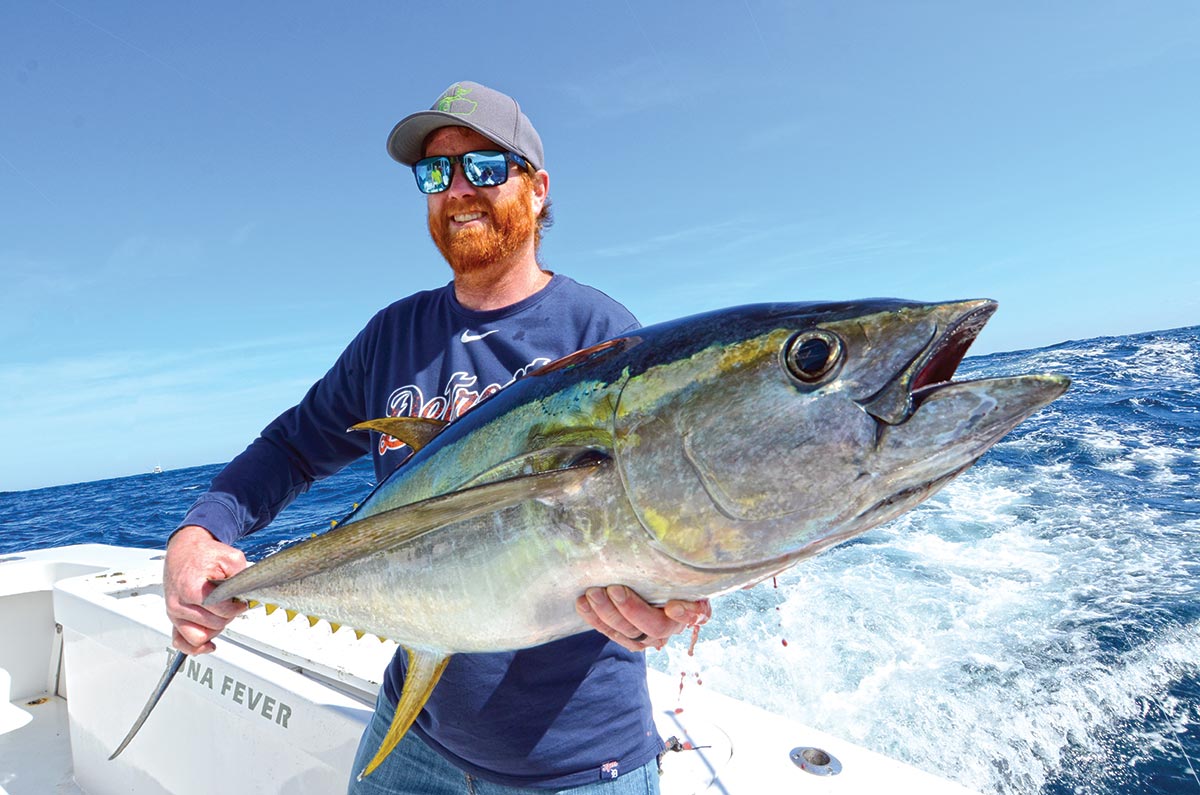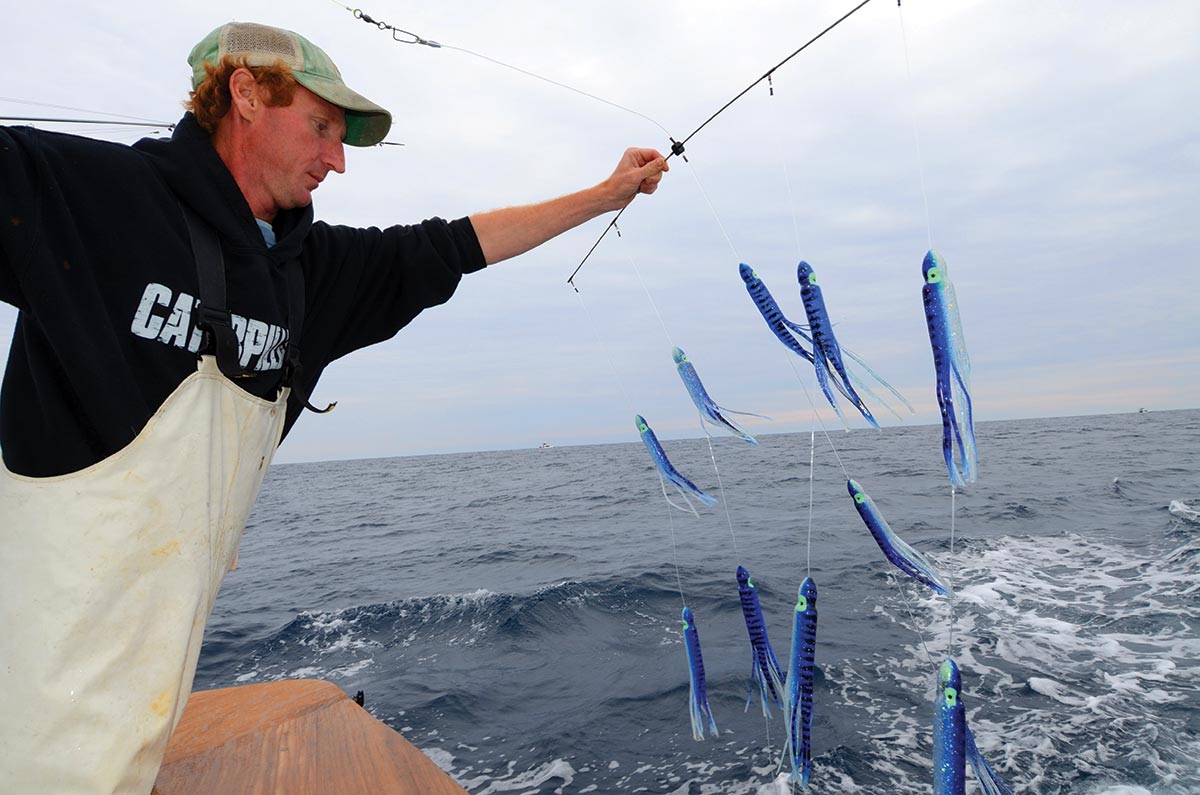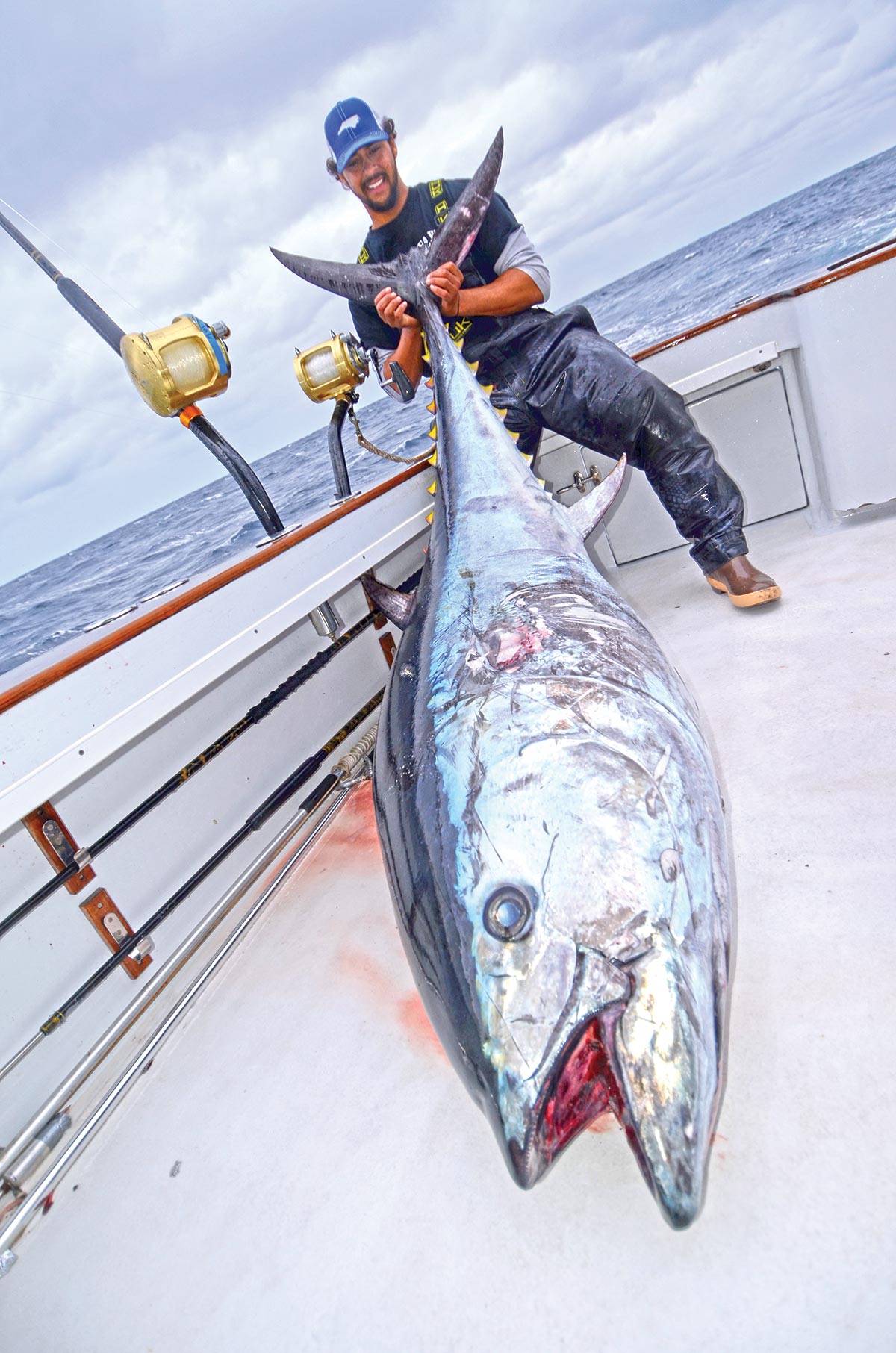
It can be a relatively short trip to pelagic territory for those looking to try their hand at tuna.
Every year Delaware anglers get a shot at bluefin and yellowfin off the coast without having to run 50 or 60 miles out to the canyons. The numerous lumps between the 20- and 30-fathom lines attract bait and the tuna hold over this structure so long as the water temperature remains to their liking.
The first to arrive are the bluefin, and you must keep a watchful eye on the latest regulations from the federal government covering these fish. It is not unheard of for the feds to shut down bluefin fishing with very little notice. The Hot Dog (38 06.88 / 74 16.68) is one of many locations where bluefin show up looking for an easy meal. Anglers should try traveling around until they find bait concentrations to locate potential fishing grounds.
On the Move
Trolling with feathers and cedar plugs at 5 to 6 knots while watching the SONAR for signs of life is the best way to cover lots of territory. I can hear some of you young bucks laughing at cedar plugs and feathers, but they worked 50 years ago and they still work today. Run a long strip of something that twists or swims (We used to use Uncle Josh Pork Rind, but try Fat Cow or Otter Tails.) on the feathers and nothing on the cedar plugs. Put the feathers on the third wake back and the cedar plugs right in the prop wash. If you have a center rigger, run a bird ahead of a Green Machine way back.
I like to run a zig-zag pattern from shallow to deep over the edge of the shoals or lumps. If there is a tide rip or weed line, I will work that the same way. Temperature breaks are another excellent piece of structure. These are often marked by a color change. The colder water is usually gray while the warmer water is bluer in color. Not the blue of Gulf Stream water, but bluer than slope water.
You would naturally think the tuna would be on the warmwater side, but not always. On rare occasions I have caught them when the boat was still in the colder, gray water. One explanation I heard is the bluewater is under the gray water and the tuna look up and see the lures. Not sure I believe this because warm water should be lighter than cold water so the blue water should be on top. Anyway, the fish were caught out of the gray water for whatever reason.

Idle Chatter
If you catch a fish mark the spot on your electronics. Once the tuna is in the boat go back and work that location again. Begin away from the location where the fish was hooked running on the same heading as when you had the strike. The captain needs to watch the SONAR and the GPS. The anglers in the cockpit will keep an eye on the lines. Continue to do this until you don’t have a strike. Then start working in an ever-increasing circle until you locate the tuna again.
Do not listen to the VHF radio unless you know the person on the other end. When I say know, I mean as in your priest or preacher, brother, man whose life you saved in Iraq or mother. Even then, make sure you have an absolute identification. This does not mean you can’t look around to see what other boats are doing. Sometimes the most important thing on a boat is a good pair of binoculars. If you see another boat hooked up do not hesitate to check out the lures he is using and don’t be shy about working towards his location.
Once the tuna establish themselves on the lumps, chunking will take over from trolling. There are always a few interactions between trollers and chunkers. Most of these involve trollers dragging lures through chunker’s chum lines. Disputes are settled with hand signals and verbal exchanges. Chunking is best at night or very early or late in the day. In doing reports since 1973, if there is a pattern I have found; it is right at dusk and dawn.
Most boats will depart around 2 or 3 p.m., run out to their chosen location, troll until late afternoon, then set up for the night. After fishing through the night, they will troll for a few hours before heading back to the dock. By trolling in the afternoon, you stand a good chance of finding fish before setting up to chunk. Once you discover a good location you may want to stick around until the time to anchor.

On the Hook
It will take a long anchor rode to set up in 20 to 30 fathoms on the hook; and I also like to use a long anchor chain. The rode and chain may be stored in plastic milk cartons when fishing on a smaller boat. You must take into consideration wind and current. The idea is to set the anchor so the boat drifts back to the edge of the shoal where the chunks will wash from shallow to deep water. Be prepared to change positions as the wind and current change during the night.
Chunking ain’t cheap. You will need at least three flats of frozen bait for chunks plus another flat of fresh bunker or whatever you can get for hook baits. This plus the extra 200 to 300 feet or more of anchor rode and chain.
I use 30-pound gear for chunking with 50-pound mono line and 40-pound fluorocarbon leader tied directly to a 7/0 or 8/0 circle hook. Sometimes the tuna get picky and I have to decrease the pound-test of the leader. I have heard some captains go down as low as 10-pound, but they don’t get any fish to the boat. I don’t go below 20 and then I try to use a chafing tube.
Chunking may also be done during the day. Everything is pretty much the same. I have never had the same success in the day as I have had at night, but others have had good catches. As the year moves along the water will warm and the bluefin will move out and the yellowfin will move in. This is when nighttime chunking really hits its stride. The surface water becomes too warm for tuna during the day, but chunking at night will bring them up to the thermocline where your baited hooks will be waiting.
Warmer weather will also bring dolphin and wahoo inshore. Last summer we had dolphin in as far as the Buoy Line and I caught some at the Del-Jersey-Land-Reef on minnows allowed to swim freely on the surface.
All of the inshore lumps are accessible from trailer boats. I first fished out here in 1973 in a 22-foot Mako. We only had a compass and a Shakespeare flasher SONAR. With today’s electronics and dependable motors there is no reason to stick within sight of land catching croaker and spot. So come on out and get a few!
| SOUTHERN HOTSPOTS | |
|---|---|
|
MASSEY’S CANYON HAMBONE 20 FATHOM FINGERS 20 FATHOM LUMPS ELEPHANT TRUNK TEA CUP |
38 19.75/74 26.50 38 12.00/74 25.00 38 10.00/74 38.50 38 03.75/74 25.00 38 32.89/74 04.64 38 20.50/74 12.00 |




